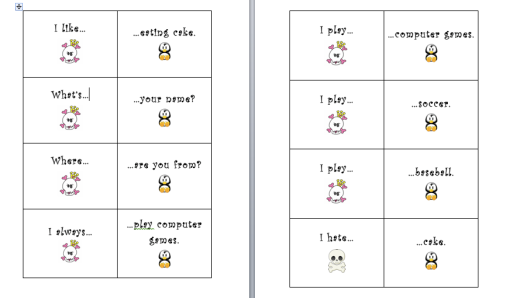I wanted to come up with a few activities to review numbers and food, but introduce colours at the same time.
This game is for beginners, 1st to 4th grade elementary.
I have made some cards which you can find in the title below for use in the following game. The cards are fully customisable
COLOUR + Food GAME CARDS
- Apple – Blue, Red, Yellow, Green, Orange, Pink, Purple, Black, White
- Tea – Blue, Red, Yellow, Green, Orange, Pink, Purple, Black, White
- Banana – Blue, Red, Yellow, Green, Orange, Pink, Purple, Black, White
- Pepper – Blue, Red, Yellow, Green, Orange, Pink, Purple, Black, White
First of all I made 3 copies of the cards 1 set each for 3 teams. I laminated them then stuck magnets to the back of each card.
After all the necessary drilling of new vocabulary, I followed with a TPR (total physical response) card game.
The first activity I tried out was a listening and speaking race.
Directions:
- Split the class into 3 teams and line them up in their teams at the back of the class with a good distance between the first student in each row and the board.
- Stick all teams cards to the board.
- give a coloured balloon to the student at the front of each team. Have those students put the balloon between their knees.
- Call out “one + COLOUR + food” (working with higher numbers = making more cards)
- The students with the balloons have to make their way to the board trying not to drop the balloon. If a s drops it he/she has to go back to the starting line.
- When they reach the board they have to collect the card you asked for then run with the card and balloon back to their team and pass both down the line with each student in turn saying what’s on the card until it reaches the student at the front of the line.
- The quickest team with the correct card gains a point. Put that card in an allocated points section for that team.
- Return the slower teams cards to the center of the board.
This game practices Listening and Speaking, with pretty much the entire class being engaged at the same time.
If you would like to use the the flash cards I used as apart of the lesson drill please click on the (4 Food Flash Cards) title below.
4 Food Flash Cards
The next activity is to put into practice what the students have just learned, but this time using items which are easy to get to around the class room.
Using the same teams, I numbered the students from 1~6 (or however many are in each team)
Number ones stand up.
I call out a number+COLOUR+item e.g “2 yellow hats”
The first student to run and return with the goods, saying what he/she has, “2 yellow hats” gains a point for their team. (I used Mario Kart characters on a race track to mark their points. The team to reach the finish line first wins stickers)









